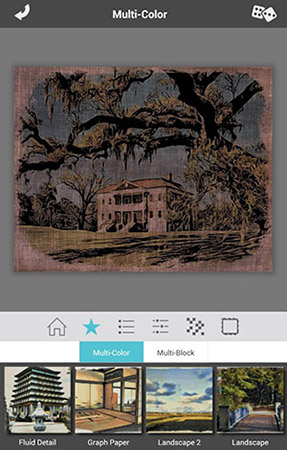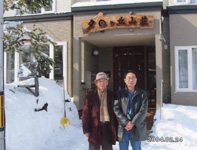
For more information about the techniques of moku hanga, see and barenforum. For a more extensive list from M.I.T., go here
Zokin: A small wooden block covered with cloth primarily used to print bokashis. Washi: traditional Japanese paper made from the bast fibers of the mulberry plant. Ukiyo-e: Literally, "floating pictures" referring to 17th>mid/late 19th century prints depicting secular subjects. Tokibo: or hakobi a small brush used to apply pigment to the block. A movement that became popular during post WWII Japan. Sosaku-hanga: "self-prints"- prints that are designed, carved, and printed by the artist. 
Shina: Japanese basswood or lindenwood often used as easily-carved woodblocks.Shin-hanga:"new prints"- refers 20th century woodblock printmaking revival often featuring layered color landscapes.
 Sakura: Japanese cherry often used for woodblocks. Ōban: a print size about 15½ by 10½ inches (39 by 26.5 cm). Nori: Paste to keep pigment in suspension made of rice, potato or tapioca. Nishiki-e: Multi-coloured woodblock printing. Moku hanga:Japanese for woodblock prints. Ita-bokashi: "block shading" a technique for producing gradation achieved by sanding or abrading the edges of the carving. Hanshita: The drawings used as a guide to later carving. Keyblock: Roughly, line blocks often containing color. Chūban: a print size about 7 by 10 inches (18 by 25 cm). I bought Blick's Wondercut linoleum, and it cuts like a dream. I got a set of 4 Namisei Moku Hanga To cutters, and I am incredibly happy with them. I finally broke down and bought some big sheets of linoleum and new cutting tools. Bokashi: A graduated color impression often seen in traditional ukiyo-e print backgrounds. Dear blog, I finished my newest linocut yesterday. Beta ban: A flat, consistent color block. Baren-suji: Impression marks made with a baren- intentional or not. Baren: The traditional printmaking "pad" that is used by manually pressing the inked block. Hanga bake have long handles, maru (round) bake resemble shoe brushes. Bake(hanga or maru): traditional Japanese printing brushes made of horse or hog hair. I’ve noticed that this reconstituting doesn’t work as well with commercial tube watercolors since there is gum added and it results in a grainy texture. I’m also not quite sure that the step of pushing the pigment through the sieve is necessary since the ground particles are much finer than the screen.Īfter printing, mixing bowls are left to dry around the printing desks and are reconstituted (unless starch paste had been added) by simply adding a little water and stirring with the tokibo without apparent problems. I was a little suprised at the Ultramarine since it is a mineral pigment. I suspect that this will result in less hard-won pigment being lost and may go a bit faster.Īs of several days later, both the Ultramarine and the Indigo did not separate to clear water. The tangihanga ceremony which Mori use to mourn the dead has changed very little over time. Mokuhankan is planning to compare this traditional method of grinding pigments with using a western-style glass muller/ glass slab combination. The idea of keeping a selection of pigments stored in ‘paste’ form in an alcohol/water mix is discussed in ‘One-Point Lesson’ #6 in another section of the Encyclopedia. Additional references: Preparing powdered pigments can be found in a “Tools and Materials” section David Bull’s Encyclopedia article. I finally realized that it wasn’t going to work while I was using yarn and a crochet hook that was far too big for what I was trying to accomplish and headed to the Michael’s to get what was called for in the video and patterns I was reading. I should have tried this one while I was up in Veazie with my mother to help out, instead I’ve been trying to read patterns and watching YouTube videos.
Sakura: Japanese cherry often used for woodblocks. Ōban: a print size about 15½ by 10½ inches (39 by 26.5 cm). Nori: Paste to keep pigment in suspension made of rice, potato or tapioca. Nishiki-e: Multi-coloured woodblock printing. Moku hanga:Japanese for woodblock prints. Ita-bokashi: "block shading" a technique for producing gradation achieved by sanding or abrading the edges of the carving. Hanshita: The drawings used as a guide to later carving. Keyblock: Roughly, line blocks often containing color. Chūban: a print size about 7 by 10 inches (18 by 25 cm). I bought Blick's Wondercut linoleum, and it cuts like a dream. I got a set of 4 Namisei Moku Hanga To cutters, and I am incredibly happy with them. I finally broke down and bought some big sheets of linoleum and new cutting tools. Bokashi: A graduated color impression often seen in traditional ukiyo-e print backgrounds. Dear blog, I finished my newest linocut yesterday. Beta ban: A flat, consistent color block. Baren-suji: Impression marks made with a baren- intentional or not. Baren: The traditional printmaking "pad" that is used by manually pressing the inked block. Hanga bake have long handles, maru (round) bake resemble shoe brushes. Bake(hanga or maru): traditional Japanese printing brushes made of horse or hog hair. I’ve noticed that this reconstituting doesn’t work as well with commercial tube watercolors since there is gum added and it results in a grainy texture. I’m also not quite sure that the step of pushing the pigment through the sieve is necessary since the ground particles are much finer than the screen.Īfter printing, mixing bowls are left to dry around the printing desks and are reconstituted (unless starch paste had been added) by simply adding a little water and stirring with the tokibo without apparent problems. I was a little suprised at the Ultramarine since it is a mineral pigment. I suspect that this will result in less hard-won pigment being lost and may go a bit faster.Īs of several days later, both the Ultramarine and the Indigo did not separate to clear water. The tangihanga ceremony which Mori use to mourn the dead has changed very little over time. Mokuhankan is planning to compare this traditional method of grinding pigments with using a western-style glass muller/ glass slab combination. The idea of keeping a selection of pigments stored in ‘paste’ form in an alcohol/water mix is discussed in ‘One-Point Lesson’ #6 in another section of the Encyclopedia. Additional references: Preparing powdered pigments can be found in a “Tools and Materials” section David Bull’s Encyclopedia article. I finally realized that it wasn’t going to work while I was using yarn and a crochet hook that was far too big for what I was trying to accomplish and headed to the Michael’s to get what was called for in the video and patterns I was reading. I should have tried this one while I was up in Veazie with my mother to help out, instead I’ve been trying to read patterns and watching YouTube videos. #Namisei moku hanga how to
The rest of the week has itself been a grabbag – lots of time on the phone with my mother (who is recovering well – thank you for all the well wishes) and sisters dipping the pieces that my mother wrote the names of Grace’s children on for her quilt, figuring out the geometry of Grace’s quilt, some more printing experiments and trying to figure out how to crochet a pineapple pattern. Now I just have to figure out how to cut down the carving tools… I got a few larger pieces and a grabbag of smaller pieces to practice on and make some stamps for freeform printing.

Shina plywood – this is a very fine grained plywood from Japan that is ideal for woodblock cutting as it is virtually grainless.These need to be cut down to match the exact size of my hand before using. A traditional set of Namisei Moku Hanga To woodblock carving tools.A bench hook to work on and hold the wood in place while carving (and hopefully avoid cutting myself).My new tools for woodblock cutting include:







 0 kommentar(er)
0 kommentar(er)
